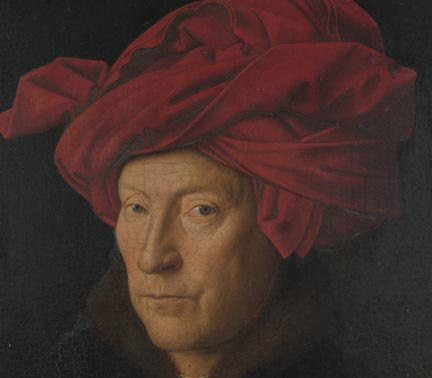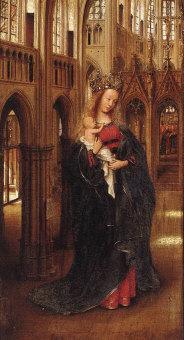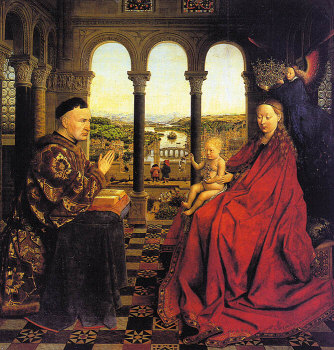|
| By: anonymous - at February 7, 2013 |
The Genius of Jan Van Eyck

According to recorded burial fees in Bruges, Jan Van Eyck died in 1441.
At the time of his death, he was believed
to be in his early fifties. Although his life was short he left an unmistakable
mark on the history of art, one in the opinion of many that has never been
surpassed. Among 15th century artists, he created a unique style. One that is
instantly recognizable. He accomplishes this through taking realism and
symbolism to new heights, two subjects with which his work has always been
strongly identified.
Painting Technique
In order to analyze his work from a perspective of realism, it is necessary to
discuss his technique. We know Vasari's claim that Van Eyck "invented"
oil-painting to be false, although a more plausible interpretation might be that
Van Eyck invented a new "technique" of oil painting. Upon first glance, this
hypothesis is easy to believe based on the brilliance of the colors alone. Vasari's notion was that Van Eyck used clearer oils than his predecessors did,
and that he painted layer upon layer of them, sometimes applying a coat of glaze
in between to prevent the colors from interfering with each other, resulting in
a translucent surface. In addition, some art restorers believe that Van Eyck
used an additional "ingredient x" mixed with his oil and that he took his secret
with him to the grave. Through his technique of using colors, Van Eyck developed
the ability to depict light in a naturalistic way, which in turn allowed him to
create details such as texture and depth. Van Eyck's masterly use of light has
been credited by some as the "birth of modern painting."
Symbolism
Symbolism is a well-known subject utilized within Van Eyck's work as well. Whether he worked in conjunction with his patron to this end, or was given
artistic autonomy is debatable. Nevertheless, it is one of the main subjects
with which his style of art is identified.
 Career Career
Jan
Van Eyck began his career as a manuscript illuminator. This helps to explain
his ability to create the small piece, Madonna in a Church, dated 1425-30, with
such intricate detail. The style of setting is said to have been derived from
the Limbourg Brother's work. Specifically, the way the viewer's eye is lead into
the depth of the church and the fact that atmospheric perspective is used. The
interior of the church is painted with remarkable skill and accuracy, although
it is known that this church does not exist. In fact, it is likely that Van Eyck
never painted a "real" scene or interior throughout his career, yet clearly he
studied churches in great detail based on his visually realistic portrayal, from
the tiles in the floor to the windowpanes above.
As realistic as the interior appears, the size of the Virgin herself is quite
unrealistic. She is super-size. This is deliberate and suggests a relationship
between realism and symbolism, both of which Van Eyck does so well. She is
represented as "The Church" and is symbolically honored repeatedly throughout
the painting in Van Eyck's realistic fashion.
 The Madonna with Chancellor Rolin, dated 1436, again includes the Virgin,
although addresses a completely different subject matter using the incorporation
of a landscape. Once again there is symbolism. Clearly Rolin is conveyed as one
who possesses an enormous amount of wealth and therefore power. During his
service under the Duke of Burgundy, he acquired one of the largest fortunes of
the day. A more subtle symbolic interpretation is one of "creation", the
painting's central theme reflected in the landscape; simultaneously depicting a
country governed and "created" by the powerful chancellor in the very center. The Christ child's head comes into contact with the landscape, signifying His
creation. Also the chancellor's prayerful hands appear to hold up a church
within the landscape depicting his belief of where the importance lies within
his own worldly creation. This again is not a real church or a real landscape. It is depicted too perfectly to be so because it is symbolic of God's perfect
creation. The Madonna with Chancellor Rolin, dated 1436, again includes the Virgin,
although addresses a completely different subject matter using the incorporation
of a landscape. Once again there is symbolism. Clearly Rolin is conveyed as one
who possesses an enormous amount of wealth and therefore power. During his
service under the Duke of Burgundy, he acquired one of the largest fortunes of
the day. A more subtle symbolic interpretation is one of "creation", the
painting's central theme reflected in the landscape; simultaneously depicting a
country governed and "created" by the powerful chancellor in the very center. The Christ child's head comes into contact with the landscape, signifying His
creation. Also the chancellor's prayerful hands appear to hold up a church
within the landscape depicting his belief of where the importance lies within
his own worldly creation. This again is not a real church or a real landscape. It is depicted too perfectly to be so because it is symbolic of God's perfect
creation.
Another possible analogy to consider is that Rolin is confessing his sins to God
Himself via the Christ child, Christ's blessing indicative of absolution. In
doing so, maybe Rolin commissioned Van Eyck with the idea of portraying himself
in an autobiographical context. Coincidentally, the production of confession
manuals reached a peak for this time and communication of his piety might have
been popularly received. Another indication supporting a confession is the
carved reliefs just above Rolin's head which depict various biblical stories. The concept of sin appears to be the main focus: the drunkenness of Noah; the
expulsion; the sin of Cain slaughtering Abel. Its placement symbolizes that he
is "mindful" of sin at this moment.
 Yet another example of Van Eyck's remarkable skill and diversity is
representative in his portraiture. He began a new style of portraiture, most of
which are very similar to one another. This is exemplified in one of the last
portraits Van Eyck produced, his wife, Margareta, dated 1439. Here, he
objectifies his subject by painting an expressionless face and placing her upon
a plain dark back ground. Van Eyck adds further interest by having her sit at a
diagonal and depicting an illusionary light source coming from her right side,
therefore casting a shadow on her left. This is monumental in Van Eyck's ability
to produce such a naturalistic skin tone, as well as every contour of her face. The result is an extremely naturalistic portrait, without the attempt of
interpreting the subject herself. This style is recognized as having been
influential on the work of Hans Holbein. Yet another example of Van Eyck's remarkable skill and diversity is
representative in his portraiture. He began a new style of portraiture, most of
which are very similar to one another. This is exemplified in one of the last
portraits Van Eyck produced, his wife, Margareta, dated 1439. Here, he
objectifies his subject by painting an expressionless face and placing her upon
a plain dark back ground. Van Eyck adds further interest by having her sit at a
diagonal and depicting an illusionary light source coming from her right side,
therefore casting a shadow on her left. This is monumental in Van Eyck's ability
to produce such a naturalistic skin tone, as well as every contour of her face. The result is an extremely naturalistic portrait, without the attempt of
interpreting the subject herself. This style is recognized as having been
influential on the work of Hans Holbein.
Final Words
The
work of Jan Van Eyck gives us a multitude of skill and artistry to dissect. One
can get aimlessly lost in his work; whether trying to interpret his clever
open-ended symbolism or just visually appreciating the realism he creates with
his jaw-dropping technique. Ultimately, I believe Van Eyck's paintings are a
reflection of himself and his patrons; both of which are human. Although in his
humanness, I personally believe him to be atop a "divine" pedestal.
Art
Graffiti Artists and Radical Media
Marcel Duchamp's Fountain
The Genius of
Jan Van Eyck |